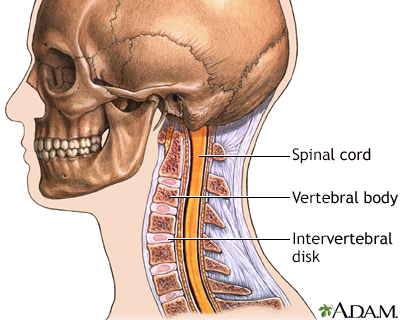Spinal surgery -- cervical
| Normal anatomy |
|
The cervical spinal column is made up of vertebral bodies which protect the spinal cord.
|
|
| Indications |
|
Cervical spine disease is usually caused by herniated intervertebral discs, abnormal growth of bony processes on the vertebral bodies (osteophytes), which compress spinal nerves, trauma, and narrowing (stenosis) of the spinal column around the spinal cord.
Symptoms of cervical spine problems include:
- pain that interferes with daily activities
- neck pain that extends (radiates) to the shoulder or arm
- weakness of arms or legs
- numbness of arms, hands, or fingers
|
|
| Incision |
|
The surgery is done while the patient is deep asleep and pain-free (general anesthesia). For the neck (cervical spine), an incision may be made either in the back of the neck (posterior cervical) or in the front side of the neck (anterior cervical), depending on the location of the problem.
|
|
| Procedure |
|
The bone that curves around and covers the spinal cord (lamina) is removed (laminectomy) and the tissue that is causing pressure on the nerve or spinal cord is removed. The hole through which the nerve passes can be enlarged to prevent further pressure on the nerve. If an intervertebral disc herniation is present, the intervertebral disc is removed. Sometimes, a piece of bone (bone graft) or metal rods (such as Harrington rods) may be used to strengthen the area of surgery.
|
|
| Aftercare |
|
Depending on the disease present and the surgery performed, mobility of the cervical spine may be limited after cervical spine surgery. Physical therapy is often indicated after surgery.
|
|

|
Review Date:
6/4/2025
Reviewed By:
C. Benjamin Ma, MD, Professor, Chief, Sports Medicine and Shoulder Service, UCSF Department of Orthopaedic Surgery, San Francisco, CA. Also reviewed by David C. Dugdale, MD, Medical Director, Brenda Conaway, Editorial Director, and the A.D.A.M. Editorial team. |
The information provided herein should not be used during any medical emergency or for the diagnosis or treatment of any medical condition. A licensed medical professional should be consulted for diagnosis and treatment of any and all medical conditions. Links to other sites are provided for information only -- they do not constitute endorsements of those other sites. No warranty of any kind, either expressed or implied, is made as to the accuracy, reliability, timeliness, or correctness of any translations made by a third-party service of the information provided herein into any other language. © 1997-
A.D.A.M., a business unit of Ebix, Inc. Any duplication or distribution of the information contained herein is strictly prohibited.
© 1997-

All rights reserved.






